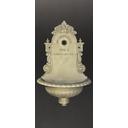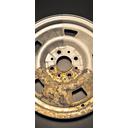Sandblasting metal
Sandblasting was initially used for: cleaning, derusting, descaling of metals, for an intermediate state, and for further processing or refining. resulting from these very technical blasting operations, a big variety of fine treatments were developed, which now are an integral part of our portfolio. Old automotive parts, cherished and cared for by classic car aficionados, get a gentle treatment. Old varnishes and rust get removed until the item is ready for a new varnish. Classy stainless steel or aluminium parts are additionally treated with glass bead. The surface gets compacted, yet the material is protected and the surface obtains a satin finish.
Application and technique
Examples of materials that can be sandblasted
- Aluminium
- Stainless steel
- Steel
- Iron
- Brass
Items made of iron are treated with chilled iron grit or steel corundum. Chilled iron grit removes persistent rust or surface coatings, while steel corundum is used subsequently in order to get a smooth surface. Stainless steel, aluminium and brass are cleaned or refined with glass beads.
Examples of application
- Clean blasting of: Cast components like park bench parts, basins, statues, car and motorcycle parts, various metal parts, rims, frames, bicycle frames, radiators, fences, metal cases, weapons, miniature models, baking trays,...
- Cleaning and removing varnish from metal surfaces
- Decorative design with patterns, logos and letterings on even surfaces
- Classic car parts: Gentle treatment of old motor and car body parts
Sandblasting material
- Corundum
- Chilled iron grit
- Glass beads
Technical information and processing details
Sandblasting only removes minor scratches. Deeper scratch marks and grinding traces are not leveled, so prior to the blasting process the surface should be ground with 100 – 150 grit. The surface of gray cast iron and of all rusting materials should be treated as soon as possible after the sandblasting in order to prevent new oxidation. If the parts are made of cast iron or similar material, there is a risk of flash rusting within a few hours. Especially in the summer and when humidity is high, rust accumulates so quickly that the surface is damaged again if there is an extended time lag between the blasting process and the subsequent treatment. Therefore, coating and refinement of the items have to be scheduled precisely. Please, also consult with your own experts before choosing a suitable surface treatment. Re-blasting that becomes necessary due to flash rust is carried out at the customer's own expense and will be charged in addition to the previously agreed on price.
To prevent distortion, the treatment of components with very thin walls generally involves a double-sided sandblasting process. Varnished parts are often coated with many different materials. In order to determine whether blasting is ideal and technically possible, a sample must first be created. If it becomes apparent that blasting alone is too expensive, it is better to treat the coated products with a lye solution prior to the actual blasting process. Partner companies of 2M are happy to assist with this.
Classic car parts: We try to treat your precious items in a particularly gentle way. This involves a double-sided blasting process with low distortion (approx. 2 bar pressure). It may be more costly, but it is a worthwhile investment. The frequently applied cheap blasting with chilled iron grit, and using 8 bar pressure, distorts the valuable car parts and makes them worthless.
Engine and car parts have to be free from soils, stickers and oils. Any bearing seats, bushes, threaded parts and unsealed grease nipples must be padded and taped carefully BY ALL MEANS in order to avoid accidental soiling with sand and dirt particles. Please use suitable tape e.g. plastic adhesive films and foils.
Attention: Thick or many layers of crepe paper strips are able to withstand the sandblasting to a limited extent only. Newspapers and old cloth rags are suitable for padding.





